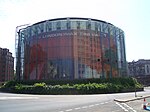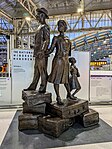Lambeth Marsh

Lambeth Marsh (also Lower Marsh and Lambeth Marshe) is one of the oldest settlements on the South Bank of London, England. Until the early 19th century much of north Lambeth (now known as the South Bank) was mostly marsh. The settlement of Lambeth Marsh was built on a raised through road over the marsh lands, potentially dating back to Roman times. The land on which it stands was owned by the church of England, with Lambeth Palace nearby. Records and maps show that it was a separate village until the early 19th Century when the church sold off the land in small pockets, thereby leading to sporadic development of individual houses rather than the grander redevelopments occurring north of the river.The northern tip of the ancient parish of Lambeth was a marshland known as Lambeth Marshe, but it was drained in the 18th century and is remembered in the Lower Marsh street name. Sometime after the opening of Waterloo railway station in 1848 the locality around the station and Lower Marsh became known as Waterloo. Lower Marsh street in the Waterloo neighbourhood of London was named after the nearby Lower Marsh. It is the location of Lower Marsh Market.
Excerpt from the Wikipedia article Lambeth Marsh (License: CC BY-SA 3.0, Authors, Images).Lambeth Marsh
Tenison Way, London Lambeth (London Borough of Lambeth)
Geographical coordinates (GPS) Address Nearby Places Show on map
Geographical coordinates (GPS)
| Latitude | Longitude |
|---|---|
| N 51.50434 ° | E -0.11283 ° |
Address
Tenison Way
Tenison Way
SE1 8SQ London, Lambeth (London Borough of Lambeth)
England, United Kingdom
Open on Google Maps











